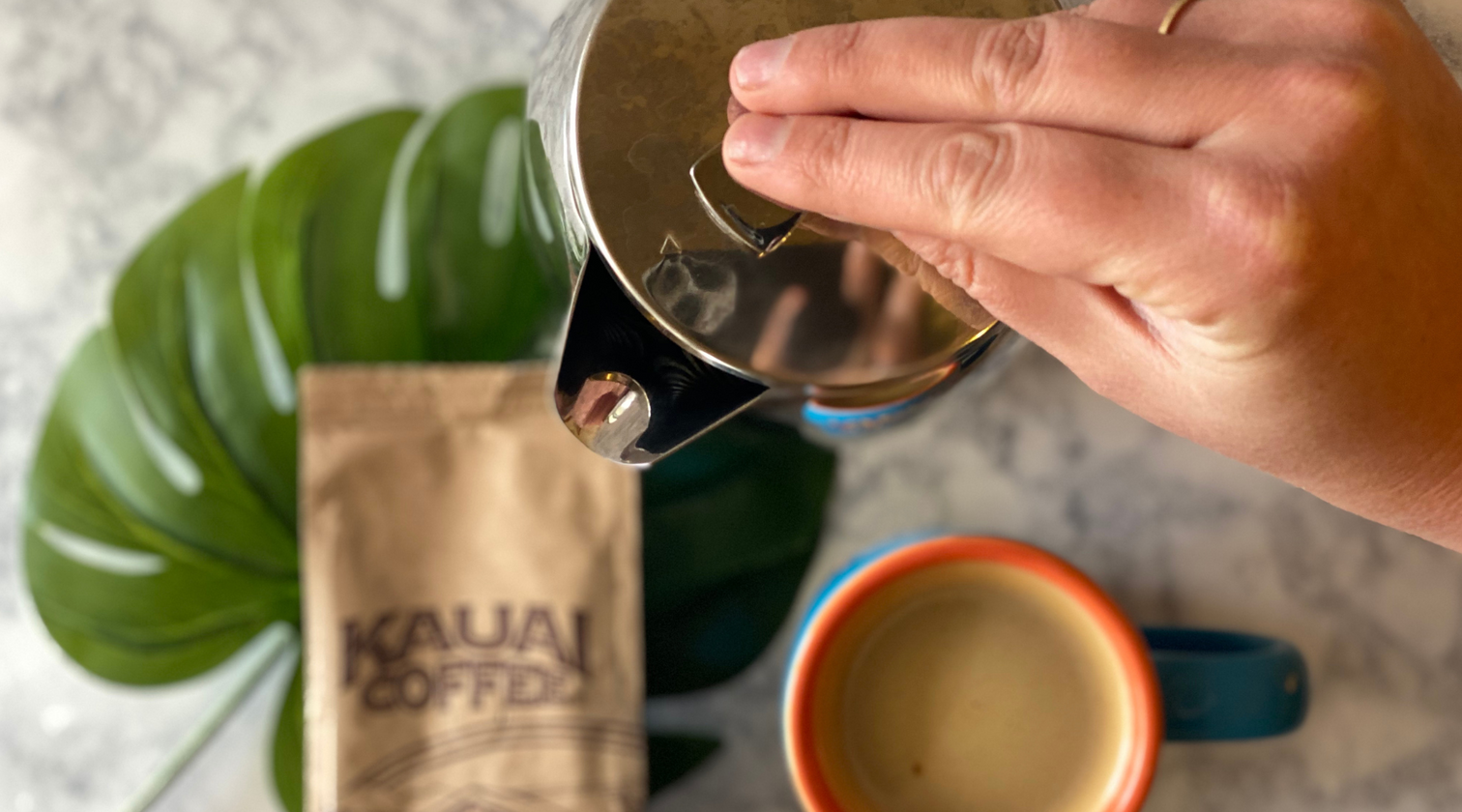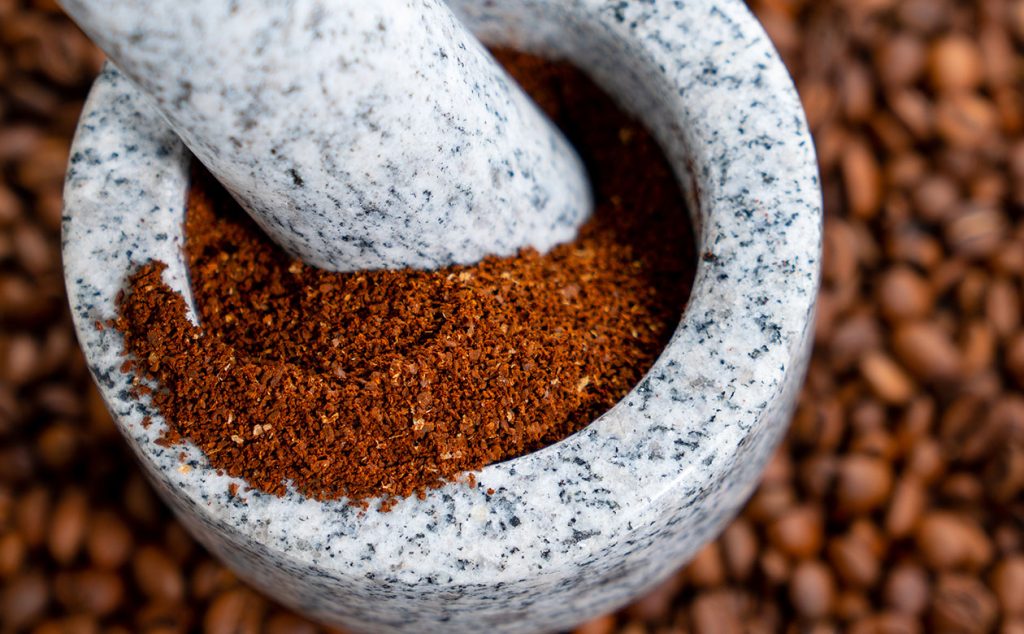
How to Grind Coffee Beans Like a Pro
Sipping a delicious cup of coffee in the morning is a delightful ritual for most Americans. From the first whiff of fresh Hawaiian coffee beans wafting from the package to the sounds of your percolator, single-serve, or drip brewer, making coffee is a comforting way to start the day.
Among U.S. households that consume coffee, only 20% use whole bean coffee at least some of the time. This means that most coffee drinkers buy and prepare ground coffee at home. Buying your coffee ground certainly saves time and energy when you're on the go, but learning how to properly blitz coffee beans at home can make a big difference in the flavor and textures you experience. Our grind guide will help you learn how to grind your coffee beans like a pro and make your next cup of Kauai Coffee your best one yet!

Why Does Grind Size Matter?
Grinding whole bean coffee right before you brew it ensures maximum freshness and flavor. Roasted coffee contains volatile oils that impart most of the flavors you taste when you consume coffee. Once beans are ground, these oils react with oxygen and evaporate. The longer your ground coffee is exposed to the air, the more flavor it may lose.
Additionally, how water interacts with your coffee during brewing profoundly affects taste and mouthfeel. Your grind size and texture are important because the more contact water has with the coffee during brewing, the quicker it will be extracted. You could accidentally prevent extraction if your grind is too fine for your brewing method.
If your grind is too coarse, water may move through your coffee too quickly and produce a weak, tasteless cup. In other words, overground or too fine coffee can be over-extracted during brewing and result in a bitter taste. Coffee that is underground or too coarse can be under-extracted during brewing and result in watery, weak, or sour-tasting coffee.

Grind Sizes
Learning how to grind coffee beans like a pro requires an understanding of the different sizes, textures, and brewing methods you can use to prepare coffee. Now that you know why grinding coffee beans matters, here are the most common names and sizes of grinds you can try at home or order from Kauai Coffee.
- Whole bean coffee is not a type of grind per se, but it is essential to know the term. Whole bean refers to un-ground coffee and is the best choice for fresh coffee prepared at home.
- Coarse grind is best for immersion brewing methods where water has a lot of contact with the coffee while brewing. A coarse perk grind should have the texture of Poipu Beach sand – gritty and granular grains you can see with the naked eye. Compare to sea salt crystals.
- Medium coarse is slightly more refined than a coarse grind used for French Press and immersion brewing and is a great choice for large pour over brewers like the Chemex, Moccamaster, and Kalita.
- Medium is the best grind size for automatic drip brewers and the most common size you'll find at the grocery store or on the shelf at your corner coffee shop. Medium grinds work best in automatic home brewers and should resemble the size and texture of fine beach sand or flaky sea salt.
- Medium fine is a fine grind for single-cup brewers like a Hario pour over or traditional AeroPress.
- Fine is the perfect grind size for espresso machines and manual espresso brewers like a Moka Pot or inverted AeroPress.
- Extra fine is a powdery grind used for making Turkish coffee. The consistency should resemble all-purpose flour or baker's cocoa powder.

Brewing Methods
Now that you are familiar with some of the most common names and sizes of grinds, it's time to pair them with your favorite brewing method like an expert.
- Immersion brewing includes methods such as French Press, percolator, and coffee cupping. During immersion brewing, ground coffee has contact with the water for an extended time, so a coarse or medium-coarse grind is most effective and flavorful.
- Drip brewing is the most popular brew method in the U.S. and includes automatic drip and single-serve machines. Use a medium grind for electric brewing methods, and you'll have a delicious and quick cup.
- Pour Over includes Hario pour-over, Chemex, and other cone-filtered methods where water is poured by hand over the ground coffee. Manual brewing gives you more flexibility and room to experiment and determine what you like since you control water flow. Try a medium coarse grind for multi-cup brewers like the Chemex or a medium-fine grind for single-cup pour overs like the Hario or traditional AeroPress.
- Pressure extraction brewing includes espresso brewing and Aeropress methods. Pressure extraction forces hot water through tightly packed and finely ground coffee to produce a robust shot with a silky layer of foam on top, known as crema. Use a fine grind to get that straight-from-the-barista flavor and texture.
- Cold brewing coffee is slightly different since there is no heat to expedite the brewing process. Because cold brewing coffee takes up to 8 hours, it is important to use a coarse grind that resembles cracked peppercorns.
- Turkish coffee combines extra finely ground coffee with sugar, water, and spices, boiling it in a small pot. An extra-fine grind is essential because Turkish coffee is served unfiltered.

At-Home Machines for Grinding Beans
You're well on your way to mastering the art of grinding coffee beans and becoming a grind guru. Now it's time to discuss the different grinders you can purchase for your home. There are four main types of grinders to look for and compare.
- Blade grinders are the most common type of home coffee grinder you can find at a kitchen equipment store near you. They feature a simple blade at the bottom of the vessel and a few speed settings. Blade grinders are best for coarse to medium grinds because their limited speed settings and single blade can deliver inconsistent results.
- Burr grinders are the preferred home grinders for many at-home coffee aficionados. Their multi-blade system creates more surfaces for coffee bean crushing, which results in a more even and consistent grind.
- Conical burr grinders are professional-grade grinders you see at your local cafe. Their conical shape and multiple speed settings provide the most accurate grind sizes and textures.
- Hand grinders are great for gourmet coffee on the go or making sure you can still prep your morning cuppa when the power goes out. Hand grinders used to be the most common at-home bean blitzing machines but ha

How to Grind Coffee Beans Without a Grinder
If you're ready to experiment with coffee grinds but not quite prepared to invest in an at-home grinder, there are many ways to test your technique and taste with the tools you already have.
- Order directly from the Kauai Coffee store. Select your preferred grind before adding coffee to your cart, and we will package and ship directly to your door. No need to worry about the loss of flavor! Your coffee is ground and sealed immediately, so there is no loss of flavor or aroma.
- Use a blender to experiment with coarse and medium grinds at home. The simple blades and low-speed setting should give you decent results.
- Use a mortar and pestle to get a consistent medium-fine to fine grind. It will take some time and elbow grease, but you should get excellent results.
- Use a food processor to pulse beans to your desired texture. Try blitzing a scant 1/2 cup of whole beans at a time for more consistent results.
- Several other kitchen tools, from rolling pins to meat tenderizers and kitchen knives, can be used to chop, crush, and grind. Experiment and have fun!

Ready to get grinding? Shop online now for 100% Kauai Coffee, and share your results with us on social media! Tag @KauaiCoffeeCo on Facebook, Instagram, and Twitter!







